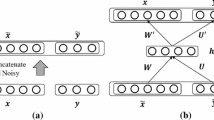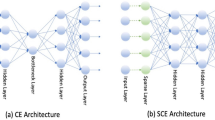Abstract
Autoencoders have been successfully used to build deep hierarchical models of data. However, a deep architecture usually needs further supervised fine-tuning to obtain better discriminative capacity. To improve the discriminative capacity of deep hierarchical features, this paper proposes a new deterministic autoencoder, trained by a label consistency constraints algorithm that injects discriminative information to the network. We introduce the center loss as label consistency constraints to learn the hidden features of data and add it to the Sparse AutoEncoder to form a new autoencoder, namely Label Consistency Constrained Sparse AutoEncoders (LCCSAE). Specifically, the center loss learns the center of each class, and simultaneously penalizes the distances between the features and their corresponding class centers. In the end, autoencoders are stacked to form a deep architecture of LCCSAE for image classification tasks. To validate the effectiveness of LCCSAE, we compare it with other autoencoders in terms of the deeply learned features and the subsequent classification tasks on MNIST and CIFAR-bw datasets. Experimental results demonstrate the superiority of LCCSAE over other methods.







Similar content being viewed by others
References
Bengio Y (2009) Learning deep architectures for AI. Found Trends Mach Learn 2(1):1–127
Xu J, Xiang L, Liu Q, Gilmore H, Wu J, Tang J, Madabhushi A (2016) Stacked sparse autoencoder (SSAE) for nuclei detection on breast cancer histopathology images. IEEE Trans Med Imaging 35(1):119–130
Yang J, Yu K, Gong Y, Huang T (2009) Linear spatial pyramid matching using sparse coding for image classification. In: IEEE conference on computer vision and pattern recognition (CVPR), pp 1794–1801
Chen Y, Luo W, Yang J (2015) Facial landmark detection via pose-induced auto-encoder networks. In: IEEE international conference on image processing (ICIP), pp 2115–2119
Luo W, Yang J, Xu W, Fu T (2015) Locality-constrained sparse auto-encoder for image classification. IEEE Signal Process Lett 22(8):1070–1073
Yu J, Rui Y, Tang YY et al (2014) High-order distance-based multiview stochastic learning in image classification. IEEE Trans Cybern 44(12):2431–2442
Erhan D, Szegedy C, Toshev A, Anguelov D (2014) Scalable object detection using deep neural networks. In: IEEE conference on computer vision and pattern recognition (CVPR), pp 2147–2154
Li LJ, Su H, Fei-Fei L, Xing EP (2010) Object bank: a high-level image representation for scene classification and semantic feature sparsification. In: Advances in neural information processing systems, pp 1378–1386
Zuo Z, Wang G, Shuai B, Zhao L, Yang Q (2015) Exemplar based deep discriminative and shareable feature learning for scene image classification. Pattern Recognit 48(10):3004–3015
Feng Z, Huber P, Kittler J, Christmas W, Wu X (2015) Random cascaded-regression copse for robust facial landmark detection. IEEE Signal Process Lett 1(22):76–80
Shu Z, Zhao C, Huang P (2015) Local regularization concept factorization and its semi-supervised extension for image representation. Neurocomputing 158:1–12
Turk M, Pentland A (1991) Eigenfaces for recognition. J Cognit Neurosci 3:71–86
Belhumeur PN, Hespanha JP, Kriegman DJ (1997) Eigenfaces vs. fisherfaces: recognition using class specific linear projection. IEEE Trans Pattern Anal Mach Intell 19(7):711–720
He X, Ji M, Bao H (2009) Graph embedding with constraints. Int Joint Conf Artif Intell (IJCAI) 9:1065–1070
Wright J, Yang AY, Ganesh A, Sastry SS, Ma Y (2009) Robust face recognition via sparse representation. IEEE Trans Pattern Anal Mach Intell 31(2):210–227
Song X, Feng Z, Hu G, Kittler J, Christmas W, Wu X (2016) Dictionary integration using 3D morphable face models for pose-invariant collaborative-representation-based classification. ArXiv preprint arXiv:1611.00284
Song X, Feng Z, Hu G, Wu X (2017) Half-face dictionary integration for representation-based classification. IEEE Trans Cybern 47(1):142–152
Lu X, Wang Y, Yuan Y (2013) Graph-regularized low-rank representation for destriping of hyperspectral images. IEEE Trans Geosci Remote Sens 51(7):4009–4018
Feng Z, Kittler J, Christmas W, Wu X, Pfeiffer S (2012) Automatic face annotation by multilinear AAM with missing values. In: 2012 21st international conference on pattern recognition (ICPR), pp 2586–2589
Feng Z, Kittler J, Christmas W, Wu X (2016) A unified tensor-based active appearance face model. ArXiv preprint arXiv:1612.09548
Lee DD, Seung HS (1999) Learning the parts of objects by non-negative matrix factorization. Nature 401(6755):788
Shu Z, Wu X, Fan H, Huang P, Wu D, Hu C, Ye F (2017) Parameter-less auto-weighted multiple graph regularized nonnegative matrix factorization for data representation. Knowl Based Syst 131:1–194
Hinton GE, Salakhutdinov RR (2006) Reducing the dimensionality of data with neural networks. Science 313(5786):504–507
Erhan D, Bengio Y, Courville A, Manzagol PA, Vincent P, Bengio S (2010) Why does unsupervised pre-training help deep learning? J Mach Learn Res 11:625–660
Poultney C, Chopra S, Cun YL (2006) Efficient learning of sparse representations with an energy-based model. In: Advances in neural information processing systems, pp 1137–1144
Glorot X, Bordes A, Bengio Y (2011) Domain adaptation for large-scale sentiment classification: a deep learning approach. In: Proceedings of the 28th international conference on machine learning (ICML-11), pp 513–520
Vincent P, Larochelle H, Bengio Y, Manzagol PA (2008) Extracting and composing robust features with denoising autoencoders. In: Proceedings of the 25th international conference on machine learning, pp 1096–1103
Hosseini-Asl E, Zurada JM, Nasraoui O (2016) Deep learning of part-based representation of data using sparse autoencoders with nonnegativity constraints. IEEE Trans Neural Netw Learn Syst 27:2486–2498
Hu C, Wu XJ (2016) Autoencoders with drop strategy. In: The 8th international conference on advances in brain inspired cognitive systems (BICS), pp 80–89
Bengio Y, Lamblin P, Popovici D, Larochelle H (2007) Greedy layer-wise training of deep networks. In: Advances in neural information processing systems, 19(153)
Hinton GE, Srivastava N, Krizhevsky A, Sutskever I, Salakhutdinov RR (2012) Improving neural networks by preventing co-adaptation of feature detectors. ArXiv preprint arXiv:1207.0580
Bourlard H, Kamp Y (1988) Auto-association by multilayer perceptrons and singular value decomposition. Biol Cybern 59(4–5):291–294
Riedmiller M (1994) Advanced supervised learning in multi-layer perceptrons-from backpropagation to adaptive learning algorithms. Comput Stand Interfaces 16(3):265–278
Wen Y, Zhang K, Li Z, Qiao Y (2016) A discriminative feature learning approach for deep face recognition. In: European conference on computer vision, pp 499–515
LeCun Y, Bottou L, Bengio Y, Haffner P (1998) Gradient-based learning applied to document recognition. Proc IEEE 86(11):2278–2324
Krizhevsky A, Hinton G (2009) Learning multiple layers of features from tiny images Vol 1, No 4. Technical report, University of Toronto, p 7
Author information
Authors and Affiliations
Corresponding author
Additional information
Publisher's Note
Springer Nature remains neutral with regard to jurisdictional claims in published maps and institutional affiliations.
This work was supported by the 111 Project of Chinese Ministry of Education under Grant B12018, the Grants of the National Natural Science Foundation of China (Grant 61373055, 61672265 and 61603159) and Natural Science Foundation of Jiangsu Province of China under Grant BK20160293.
Rights and permissions
About this article
Cite this article
Hu, C., Wu, XJ. & Shu, ZQ. Discriminative Feature Learning via Sparse Autoencoders with Label Consistency Constraints. Neural Process Lett 50, 1079–1091 (2019). https://doi.org/10.1007/s11063-018-9898-1
Published:
Issue Date:
DOI: https://doi.org/10.1007/s11063-018-9898-1




